How Does Your Garden Grow?
A Project-Based Approach to Learning.
Introduction | Background Knowledge | Activities | Extensions | Standards
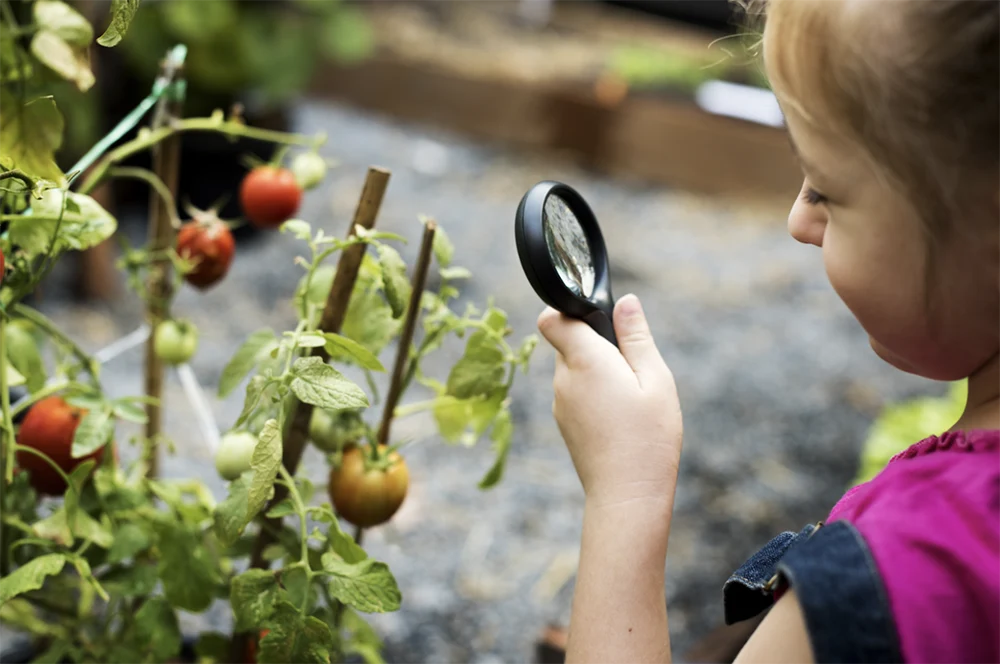
Introduction
Facilitating an immersive classroom or school project will encourage implementing every aspect of the curriculum while getting their hands dirty! Students learn the benefits of cooperation as they work together to prepare the space, plant and tend to the seeds, and finally harvest the crops. Many students do not know where their food comes from. A garden project is a smaller-scale farm-to-table experience. A school garden can also encourage students to try vegetables. Kids are more likely to try vegetables they have planted themselves.
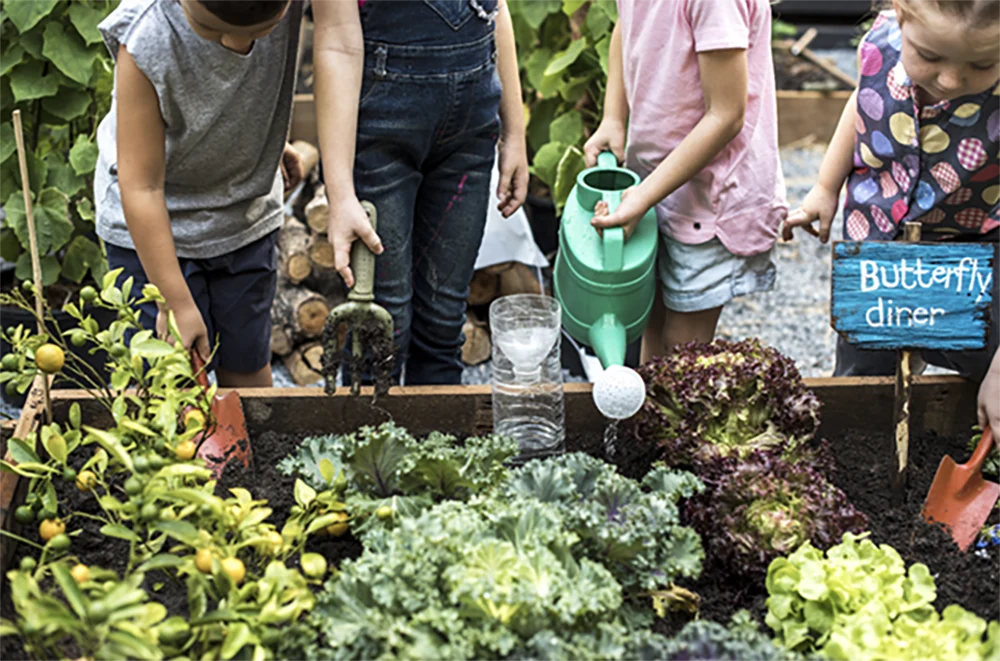
Background Knowledge
The first school garden in the United States was planted in 1891 in Roxbury, Massachusetts. At that time, gardens were seen as a way to keep the growing numbers of unruly schoolchildren occupied. By 1906, there were about 75,000 gardens in schools across America. The number of school gardens across the country peaked during World War I when the demand for surplus food diminished, and Victory Gardens were no longer needed. There was a renewed interest in school gardens for a short time in the 1970s and 1990s. More recently, school gardens have returned to popularity with Eat Local! movements and Farm-to-Table initiatives.
Mary Louise Green defined a school garden in 1910. She stated that “a school garden may be defined as any garden where children are taught to care for flowers, for vegetables, or both, by one who can, while teaching the life history of the plants, and of their friends and enemies, instil [sic] in the children a love for outdoor work and such knowledge of natural forces and their laws as shall develop character and efficiency.”
Some supporters of the school garden movement believed that each student should have his or her own plot to garden. Others, such as George Washington Carver, thought that small groups of children should work in partnership on a plot with a contract to set expectations. Others still maintained that a school garden should be a collaborative effort of all students.
In the school garden of the 2020s, students are scientists and mathematicians as much as they are farmers. Students can calculate the volume of a raised bed or garden plot to determine their needed soil. They can calculate the garden’s perimeter to build a fence to keep out local rabbits and deer. They can find the garden’s area and use a grid system to determine how to arrange the plants. Students need to learn their growing zone to plant the right crops at the right time. They also need to observe how the sun moves throughout the day so they don’t plant tall plants that may provide shade for other plants that might thrive in the sun. Once the garden is planned and the seeds are planted, students can observe weather conditions and determine cause-and-effect relationships for their project. Once the plants are ready for harvest, students can research recipes and learn about food handling safety.
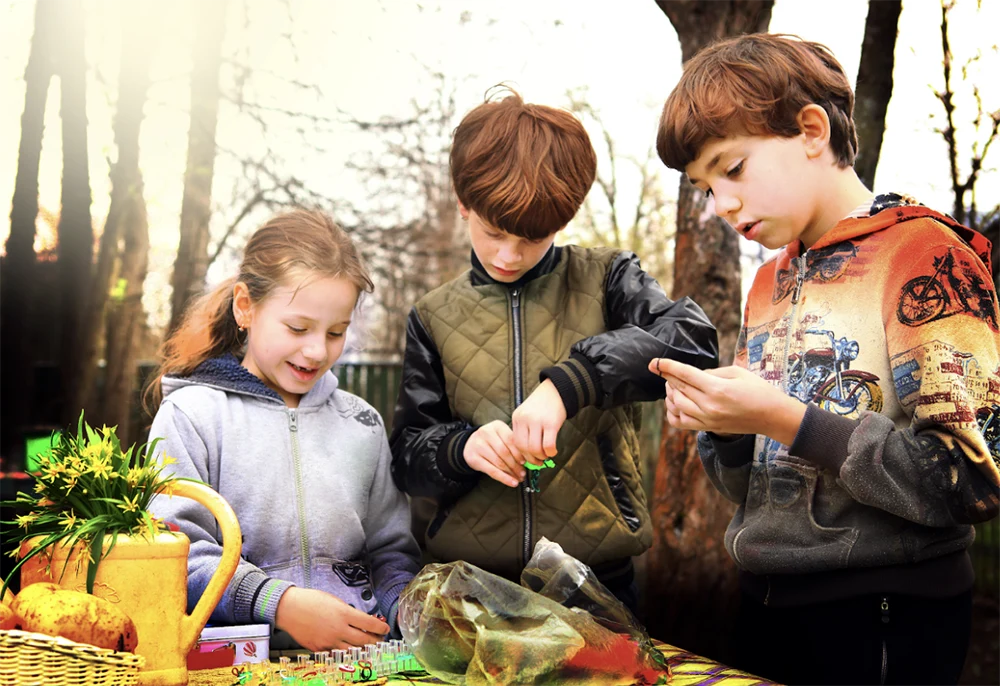
ACTIVITIES
Start with Literature
Begin with And Then It’s Spring by Julie Fogliano (ISBN 9781596436244). This easy picture book centers around a young boy tired of the cold, dreary winter and decides to plant a garden in the spring. He anxiously waits for it to grow. Students can connect to the feelings about winter and the anticipation of spring!
Other Options for Literature:
- The Tiny Seed by Eric Carle (ISBN 9780689842443)
- Flower Garden by Eve Bunting (ISBN 9780152023720)
- Lola Plants a Garden by Anna McQuinn (ISBN 9781580896955)
- The Curious Garden by Peter Brown (ISBN 9780316015479)
- Our School Garden by Rick Swann (ISBN 978-0998436630)
- The Gardener by Sarah Stewart (ISBN 978-0374325176)
Ask a Question
How can we plant a garden in our classroom? (In our school, in our home)
Activate Prior Knowledge
- Brainstorm what students KNOW about gardens.
- Brainstorm what students NEED TO KNOW to answer the question.
Gather Information
- Learn about planning a garden at Gardener’s Supply Company Website (TeachersFirst review). This is a FREE tool for research and planning! It allows students to explore pre-planned gardens and plan their own with a drag-and-drop feature. The tool shows students how many of each plant will fit in the space and provides a planting guide for each of the chosen plants. It also allows for research on USDA growing zones. Throw in a quick discussion about WHY this is a reliable source.
- Map out a garden on graph paper. Students can practice area and perimeter skills as they plan out their gardens.
- Check out one of the curated gardening collections by Epic users at Epic Books (TeachersFirst review)
- The nonfiction section of the school library is also an excellent resource for nonfiction books. Try and find a Plant Encyclopedia! Students can look through the books to find the exact information presented on the Gardener’s Supply Company website and at Epic Books.
- Review the lessons for older students from Project S.O.W. (TeachersFirst review)
- Use a Digital Camera (on a device or with an actual camera) to document the process from bare ground to bountiful garden. Put the still photos or any video footage together with movie-making tools. Try a tool such as Adobe Express Video Maker (TeachersFirst review) or another video-making tool from this list.
- Ask garden stores or online stores for seed catalogs. Students can cut out pictures of plants and arrange them in draft gardens or use the images for final projects.
Start Planting!
-
Consider the advantages of starting a school garden to provide learning opportunities for students to understand plant growth cycles while harvesting the bounty for use in nutritious meals and snacks.
- School Garden Resources (TeachersFirst review) is an excellent starting point for information about planning, planting, and harvesting a school garden.
- Visit The Edible School Project (TeachersFirst review) to find a large resource library that includes many lesson plans related to gardening that encourage students to learn about ecosystems, food justice, types of gardening, and more through hands-on experiences.
- This TeachersFirst blog post shares the many benefits and resource ideas for school gardens. Another TeachersFirst blog shares 5 Steps to Planning a Succesful Garden; included are suggestions for creating a garden when outdoor space isn’t available.
-
Several grant programs provide seeds to schools for free. They may not fit the students’ garden vision, but it is a start.
- Seed Savers - Fifty packets of seeds from Herman’s Garden are donated to nonprofit organizations to plant gardens. Recipients will pay $15 for shipping and handling.
- Grow Organic - Expired seeds are sent to schools and community gardens. Recipients are asked to post a sign at the garden recognizing Grow Organic for the donation.
- Save Our Monarchs - Schools, scouts, and 4H clubs can enroll in the Monarchs Pollinator Garden Program. Participants will receive seed packs, which include wildflowers, milkweed, annuals, and perennials.
Show What You Know
- Make a movie tour of the garden with voiceovers explaining what the students accomplished. Try FlexClip (TeachersFirst review) or Renderforest (TeachersFirst review) if your school does not have tablets with movie-making apps available.
- Create Google Slides (TeachersFirst review) or a PowerPoint Online (TeachersFirst review) presentation of the process and the product. Find many templates for gardening at Slidesacademy (TeachersFirst review).
-
Make a digital presentation using free online resources:
- Animoto (TeachersFirst review) - use the drag-and-drop features and video templates to share pictures and videos of your garden successes (and missed opportunities!). The Vocabulary Lesson template is one example; begin your video using the template, then quickly customize the content to tell your garden story. Learn more about how to create videos by visiting the Animoto Education Center.
- Adobe Express for Education (TeachersFirst review) offers a robust selection of education templates in several different formats for students to share learning. Choose from animated templates, multiple-page presentations, and video templates. Try the search feature using the keyword gardens to find many ideas to use with presentations. Tip: premium content is identified using a crown icon; look for thumbnails that don’t have the crown in the bottom-right-hand corner.
- Slideful (TeachersFirst review) creates free online slideshows using your JPG or PNG images. After uploading images, follow each of the steps to customize the look of your presentation and add descriptions to each image if desired.
- SlidesGo (TeachersFirst review) enter your description, and Slidesgo uses artificial intelligence (AI) to generate a slideshow. After the slide presentation is generated, use the tools included on the site to change images and backgrounds and adjust the text to fit your needs. When finished, download the presentation or share it using the presentation option available in SlidesGo.
- Invite other classes or grade levels to tour the garden while explaining the process and the products. Use Canva (TeachersFirst review) to make flyers or brochures describing your garden or create labels to identify the plants found in your garden.
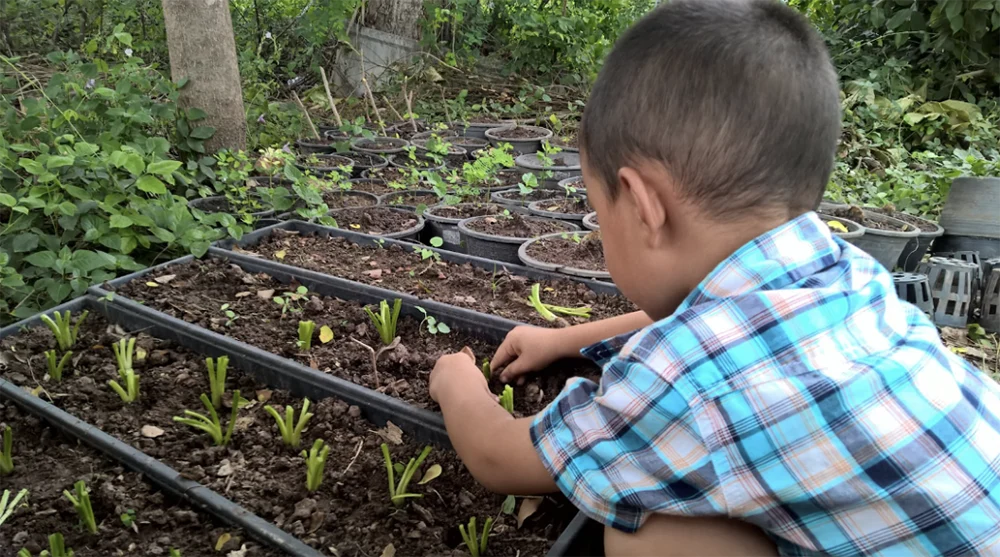
EXTENSIONS
- Composting
-
Math
- As the plants begin to grow, students can measure height and graph changes over time or compare plants.
-
Edible Parts of the Plant
- Students can harvest their plants and sort them by part of the plant. (For example, carrots are roots, lettuce is leaves, and tomatoes are fruits.) For added fun, the students can taste the different vegetables they grew. Enhance the lesson by reading Tops and Bottoms by Janet Stevens (ISBN 978-0152928513).
-
Cooking
- Students can take their plants and make them into a final dish. They can make a salad or try various cooking techniques if appliances are available. Cooking also works on steps in a sequence and following directions.
-
History Lessons
- Check out Diana’s White House Garden by Elise Carbone (ISBN 9780670016495). Talk about how Americans planted gardens during World War II to feed their families when all available resources were being used to support the war effort.
-
Life Cycles
- Planting a garden allows students to see the life cycle of a plant in action. Using observation, students can keep a journal of what they see from seed to plant. Try extending this to animals that benefit from the plant. For example, plant a butterfly garden and bring caterpillars in. Students can observe two life cycles at once.
-
Pollination
- Extend the garden lesson by learning about bees and other pollinators and how they help plants grow! The California Academy of Sciences has an excellent lesson plan (TeachersFirst review) to explore this topic.
-
Community Outreach
- Many local garden clubs or community gardens participate in the Plant a Row for the Hungry initiative.
-
STEM
- Create a pinecone bird feeder (try sun butter or suet instead of peanut butter). Students can extend their garden project by inviting birds to their space. A great, earth-friendly way is to make a biodegradable bird feeder. Simply tie a string on a pinecone, roll it in peanut butter (or sun butter or suet if there are allergy concerns), roll that in birdseed, and hang your finished bird feeders outside.
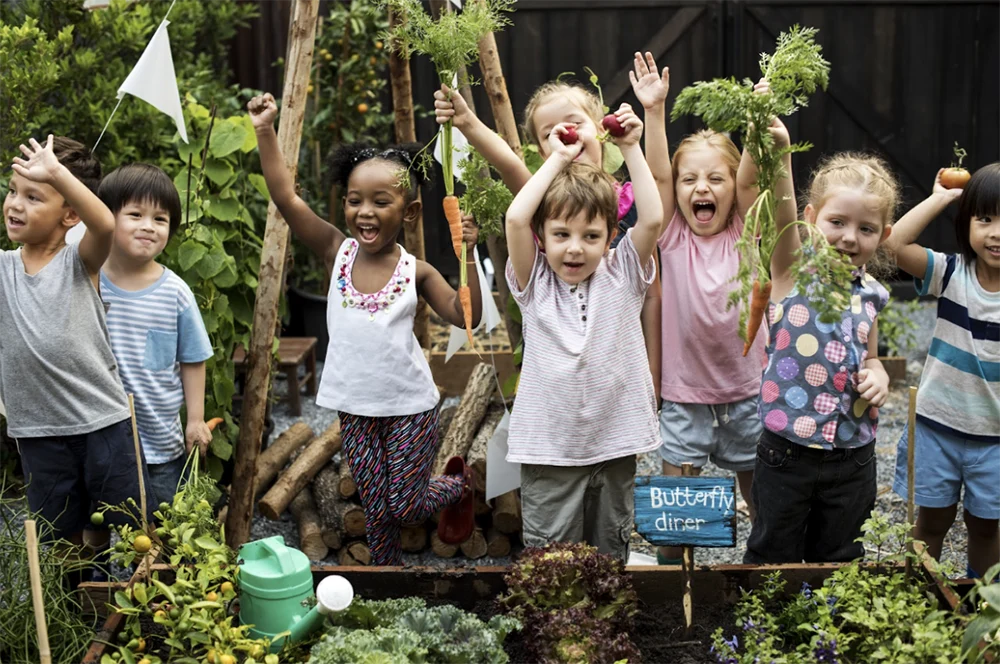
CORRELATION TO STANDARDS
- AASL National School Library Standards
- Inquire Shared Foundation, Think Domain - Learners display curiosity and initiative by: 1. Formulating questions about a personal interest or a curricular topic. 2. Recalling prior and background knowledge as context for new meaning.
- Inquire Shared Foundation: Create Domain: Learners engage with new knowledge by following a process that includes: 1. Using evidence to investigate questions. 2. Devising and implementing a plan to fill knowledge gaps.
- Inquire Shared Foundation, Share Domain - Learners adapt, communicate, and exchange learning products with others in a cycle that includes: 1. Interacting with content presented by others. 2. Providing constructive feedback. 3. Acting on feedback to improve. 4. Sharing products with an authentic audience.
- Include Shared Foundation, Share Domain - Learners exhibit empathy with and tolerance for diverse ideas by: 1. Engaging in informed conversation and active debate. 2. Contributing to discussions in which multiple viewpoints on a topic are expressed.
- Include Shared Foundation, Grow Domain - Learners demonstrate empathy and equity in knowledge building within the global learning community by: 1. Seeking interactions with a range of learners.
- Collaborate Shared Foundation, Think Domain - Learners identify collaborative opportunities by: 1. Demonstrating their desire to broaden and deepen understandings. 2. Developing new understandings through engagement in a learning group. 3. Deciding to solve problems informed by group interaction.
- Collaborate Shared Foundation, Create Domain - Learners participate in personal, social, and intellectual networks by: 1. Using a variety of communication tools and resources. 2. Establishing connections with other learners to build on their own prior knowledge and create new knowledge.
- Collaborate Shared Foundation, Grow Domain - Learners actively participate with others in learning situations by: 2. Recognizing learning as a social responsibility.
- Explore Shared Foundation, Think Domain - Learners develop and satisfy personal curiosity by: 1. Reading widely and deeply in multiple formats and writing and creating for a variety of purposes.
- Explore Shared Foundation, Create Domain - Learners construct new knowledge by: 1. Problem solving through cycles of design, implementation, and reflection.
- Explore Shared Foundation, Share Domain - Learners engage with the learning community by: 3. Collaboratively identifying innovative solutions to a challenge or problem.
- Explore Shared Foundation, Grow Domain - Learners develop through experience and reflection by: 1. Iteratively responding to challenges. 2. Recognizing capabilities and skills that can be developed, improved, and expanded. 3. Open-mindedly accepting feedback for positive and constructive growth.
-
ISTE Standards for Students
- Empowered Learner - 1b. Students build networks and customize their learning environments in ways that support the learning process. 1c. Students use technology to seek feedback that informs and improves their practice and to demonstrate their learning in a variety of ways.
- Knowledge Constructor - 3d. Students build knowledge by actively exploring real-world issues and problems, developing ideas and theories, and pursuing answers and solutions.
- Innovative Designer - 4d. Students exhibit a tolerance for ambiguity, perseverance, and the capacity to work with open-ended problems.
- Computational Thinker - 5c Students break problems into component parts, extract key information, and develop descriptive models to understand complex systems or facilitate problem-solving.
- Global Collaborator - 7c. Students contribute constructively to project teams, assuming various roles and responsibilities to work effectively toward a common goal.
